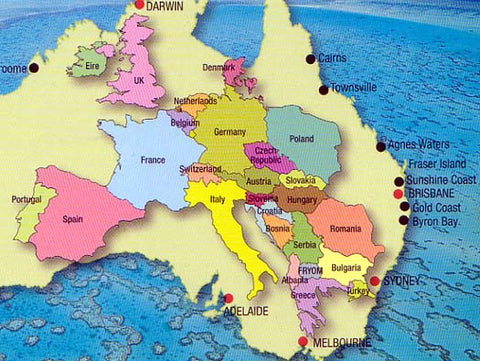
Is Australia Bigger than Europe? Compare the Two
Share
When it comes to geography, Australia and Europe are two vastly different continents. Australia is known for its vast open spaces and rugged landscapes, while Europe is known for its rich cultural heritage and historical landmarks. But which continent is bigger? In this post, we'll compare the two and see how they measure up.
Jetting off to Europe soon? Don't leave without checking out our eSIM Europe, designed for hassle-free travel connectivity
Table of Contents
- The Size of Australia and Europe
- Geography
- Climate
- Frequently Asked Questions
- Q: Is Australia bigger than Europe in terms of land area?
- Q: How does Australia's population compare to Europe's?
- Q: What are some unique natural features of Australia?
- Q: What are some famous landmarks in Europe?
- Q: Which continent has more cultural diversity, Australia or Europe?
- Q: Is Europe more densely populated than Australia?
The Size of Australia and Europe
Australia is bigger than Europe in terms of land area. Australia, which is both a country and a continent, covers an area of about 7.69 million square kilometers (2.97 million square miles). Europe, on the other hand, covers an area of about 10.18 million square kilometers (3.93 million square miles) if you include the European part of Russia. However, if you exclude Russia's European portion, Europe's land area is approximately 6.1 million square kilometers (2.36 million square miles), making it smaller than Australia.

Population
While Australia is larger in terms of land area, Europe has a much larger population. According to the United Nations, Europe has a population of approximately 747 million people, while Australia has a population of approximately 25 million people. This means that Europe is much more densely populated than Australia, which has vast open spaces with very low population densities.
Geography
The geography of Australia and Europe is vastly different. Australia is known for its vast deserts, rugged mountains, and stunning coastline. In contrast, Europe has a diverse landscape that includes mountains, forests, lakes, and rivers. Europe also has a much more moderate climate than Australia, which has a hot and dry climate, particularly in the central and northern regions.
Traveling in Australia and Europe
Traveling in Australia can be challenging due to the vast distances between cities and towns. It is recommended that visitors plan their journeys carefully and take necessary precautions when traveling in remote areas. Europe, on the other hand, has a well-developed transportation system that makes it easy for visitors to travel between countries and cities. This makes Europe a popular destination for travelers who want to explore multiple countries and cultures in one trip.
Climate
Australia is known for its hot and dry climate, with summer temperatures often exceeding 40°C. Europe, on the other hand, has a more moderate climate, with temperatures ranging from below freezing in winter to around 30°C in summer. The climate in Europe varies depending on the region, with Mediterranean countries such as Italy and Greece experiencing hot summers and mild winters, while countries in Northern Europe such as Norway and Sweden experience colder temperatures year-round.
Tourist Attractions
Australia is known for its natural beauty and outdoor attractions such as the Great Barrier Reef, Uluru, and the Australian Outback. In contrast, Europe is known for its rich cultural heritage and historical landmarks such as the Eiffel Tower, the Colosseum, and the Tower of London. Both continents offer a wide range of attractions for travelers, and the choice of destination ultimately depends on the individual's interests and preferences.
While Australia is larger in terms of land area, Europe has a much larger population and a diverse landscape. Both continents have their own unique attractions and challenges for travelers. Whether you're planning a trip to Australia or Europe, it's important to do your research and plan your trip carefully to make the most of your experience.
Thanks for visiting our blog, are you planing to travel to Europe? Check out our Europe SIM card before you take off.
Before you take off make sure to check with local government of the travel status.
Frequently Asked Questions
Q: Is Australia bigger than Europe in terms of land area?
A: No, Europe is larger than Australia when it comes to land area. Australia is the world's sixth-largest country, while Europe is the second-smallest continent.
Q: How does Australia's population compare to Europe's?
A: Australia's population is significantly smaller than Europe's. While Australia is home to approximately 25 million people, Europe has a population of over 740 million.
Q: What are some unique natural features of Australia?
A: Australia is known for its unique natural wonders, including the Great Barrier Reef, Uluru (Ayers Rock), the Outback, and the diverse range of endemic wildlife.
Q: What are some famous landmarks in Europe?
A: Europe boasts numerous famous landmarks, such as the Eiffel Tower in Paris, the Colosseum in Rome, the Acropolis in Athens, and the Sagrada Familia in Barcelona.
Q: Which continent has more cultural diversity, Australia or Europe?
A: Europe is renowned for its cultural diversity, with each country offering its own distinct traditions, languages, and cuisines. While Australia is culturally diverse, Europe's long history and varied geography contribute to its unparalleled richness.
Q: Is Europe more densely populated than Australia?
A: Yes, Europe has a significantly higher population density compared to Australia. The concentration of people in European cities is much greater due to the continent's long history of settlement and development.








